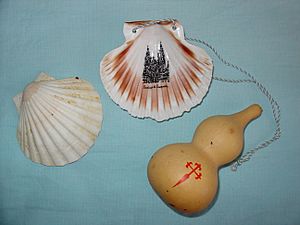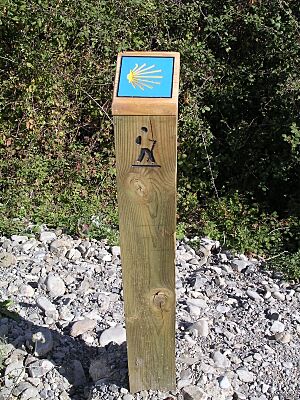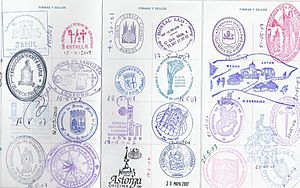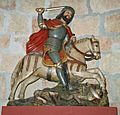Way of St. James facts for kids
The Way of St. James or St. James' Way (known as El Camino de Santiago in Spanish) is a famous journey to the Cathedral of Santiago de Compostela in Galicia, a region in northwestern Spain. For centuries, people have walked this path as a pilgrimage. It is believed that the apostle Saint James is buried in the cathedral there.
| UNESCO World Heritage Site | |
|---|---|
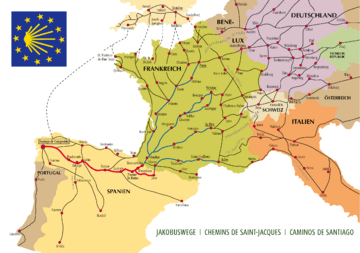
Map of the Way of St. James in Europe
|
|
| Criteria | Cultural: (ii)(iv)(vi) |
| UNESCO World Heritage Site | |
| Official name | Routes of Santiago de Compostela: Camino Francés and Routes of Northern Spain |
| Inscription | 1993 (17th Session) |
| Extensions | 2015 |
| Buffer zone | 16,286 ha (62.88 sq mi) |
| UNESCO World Heritage Site | |
| Official name | Routes of Santiago de Compostela in France |
| Inscription | 1998 (22nd Session) |
| Area | 97.21 ha (0.3753 sq mi) |
Contents
What is the Camino de Santiago?
The Camino de Santiago is not just one path, but a network of many routes across Europe. All these paths lead to the city of Santiago de Compostela. People have been walking these routes for over a thousand years. It is one of the most important Christian pilgrimages, along with journeys to Rome and Jerusalem.
Why Do People Walk the Camino?
Many people walk the Camino for different reasons.
- Some go for religious reasons, to honor Saint James.
- Others walk for spiritual growth or to find peace.
- Many people enjoy the challenge of the long walk.
- It is also a great way to meet new people from all over the world.
- Some simply want to explore the beautiful landscapes and historic towns.
History of the Pilgrimage
The pilgrimage became very popular in the Middle Ages. Thousands of people traveled to Santiago de Compostela. They believed that walking the Camino would bring them blessings. Along the way, towns and churches grew to support the pilgrims. Hospitals were built to care for those who fell ill.
The French Way
The most famous route is the Camino Francés, or the French Way. It starts in the French Pyrenees mountains and crosses northern Spain. This route is well-marked and has many places for pilgrims to stay.
Symbols of the Camino
There are a few important symbols you will see along the Camino.
The Scallop Shell
The scallop shell is the most famous symbol of the Camino.
- Pilgrims often wear a scallop shell on their backpacks or hats.
- In the past, pilgrims might have used the shell to drink water.
- It also represents the many paths that come together, like the grooves on a shell, all leading to one point.
The Yellow Arrow
Along the routes, you will see yellow arrows painted on trees, rocks, and buildings. These arrows guide pilgrims all the way to Santiago. They are a simple but very important sign for anyone walking the Camino.
Life on the Camino
Walking the Camino is an adventure. Pilgrims usually walk many miles each day. They stay in special hostels called albergues. These places offer simple, affordable beds for pilgrims.
The Pilgrim's Passport
Pilgrims carry a "credencial" or pilgrim's passport. They get stamps in it along the way from churches, hostels, and cafes. This passport shows how far they have walked. It also allows them to stay in the albergues.
World Heritage Site
Parts of the Way of St. James are recognized as a World Heritage Site by UNESCO. This means they are very important historical and cultural places that should be protected. The main parts are the Camino Francés in Spain and several routes in France.
Images for kids
-
Monument of the pilgrims, Burgos
-
St. James the Moor Slayer (Carrión de los Condes)
-
A marking in a boardwalk of the Portuguese coastal way: Coastal sands dunes of Póvoa de Varzim.
-
St. James's shell, a symbol of the route, on a wall in León, Spain
See also
 In Spanish: Camino de Santiago para niños
In Spanish: Camino de Santiago para niños


